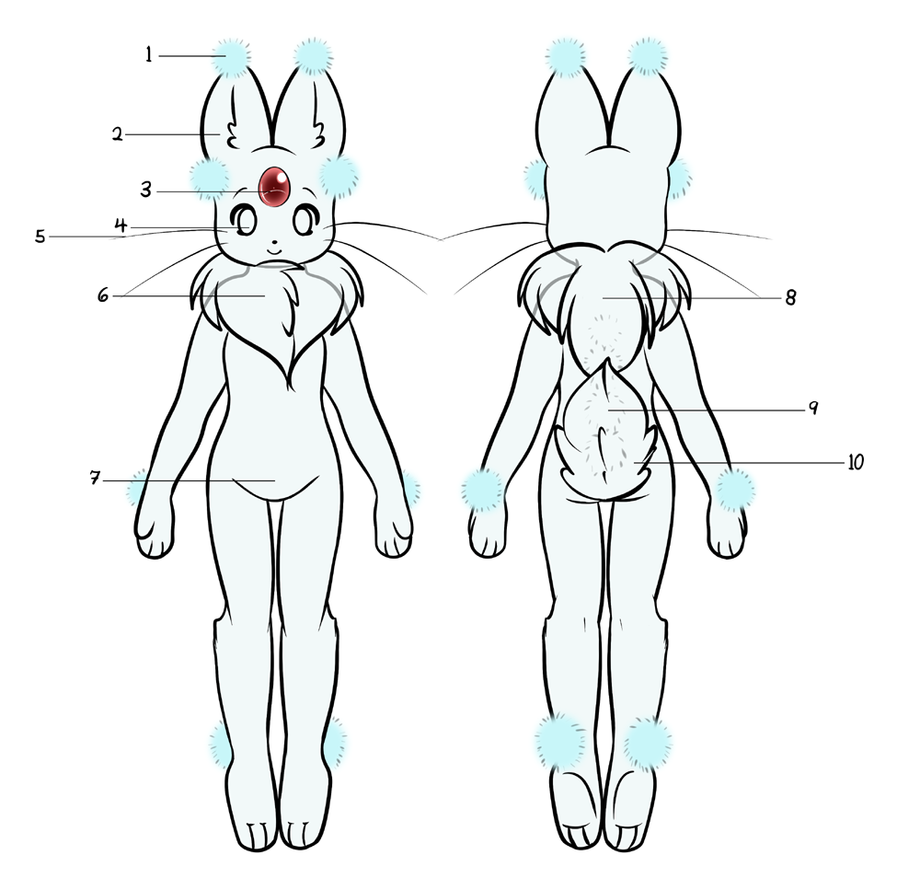Fluuns are a bunny-like creature, but are related to plants. They value nature, and most of them will even live in the wild(mostly in forests) in order to be closer to it. Living in the city isn't well seen, but isn't either forbidden. Often, a Fluun who will decide to live in the city will go back to the forest once old. Childs born in the city will at one point in their life have the occasion of trying life in the forest. If they decide to leave, but their parent(s) wish to stay, they'll be taken in by relatives. In the case that they have no relatives, they will have to wait until mature before they are allowed to leave, as being on their own is harder, and more time to think is advised.
1. The soft tufts grow on multiple specific spots on the body, being the tip and outer base of the ears, the wrists, ankles, and along the spinal column(more info on 9). They are actually moss, and a visual guide to the current health of the Fluun. The texture ranges from down soft, to an slimy, algae like consistency. The softer the moss, the healthier the Fluun!
The moss is not solidly attached to the spot it grows on, so it is pretty easy to take it off, even if by mistake. A lack of moss is not a sign of bad health!! The skin under the moss is rougher than on the other parts of the body.
It gathers sunlight(or artificial light) during the day, and is slightly phosphorescent in the dark. The light it'll carry will depends on how much of it was absorbed before it was dark.
2. Fluuns have very good hearing, though pretty sensitive ears, which is one of the reasons why most of them will not like life in the city.
3. The jewel on their forehead is made from solidified sap, which Fluuns have in stead of blood. A tiny hole in their forehead lets the older "blood" seep out, making place for new, fresher sap. The jewel is a darker tint of their sap colour, which isn't the same for all Fluuns. Illnesses will often cause a change in the sap colour, which will in return cause imperfections in the jewel colour. Fluuns which are more prone to illnesses will often end up with stripes in theirs.
The jewel is also a good way to guess on a Fluun's age, as it grows bigger with time.
While chips and scratches don't matter on a well being level, removal of the jewel should never be done. It'll end up in life threatening pain and headache, and in the case of an illness causing the sap to be more liquid, the Fluun would be at risk of bleeding to death.
4. While they can see very well during day time(Or with a source of artificial light), and rarely require glasses, Fluuns have a lot of trouble seeing as soon as it gets darker. The glow of their moss then helps a little, but most activity will stop once there isn't enough light to see correctly.
5. Fluuns' whiskers allow them to direct themselves a little better in the dark, as well as to sense changes in the weather.
6. The fur collar around their neck gets denser when the cold season arrives. It can be shaven or trimmed with no consequences, but like hair, it'll grow back.
7. Being in most part mammalians, Fluuns reproduce the same way most of them do. The gestation time is of roughly 9 moths.
8. Fur on the back of the collar grows longer faster than the front and the sides, and has a more hair-like texture.
9. The moss on the back grows in a line, following the spinal column. It starts at the base of the tail, and goes up to a bit lower than the shoulders.
10. Their tail is dense, and required for balance.
Lore needs to be re-worked.
Details
Published:
11 years, 5 months ago
07 Feb 2014 23:48 CET
Initial: bf1dd79e29dfc4291dc9e8f5445bcf2d
Full Size: f4755e724ca854e97561e61d8ff7cdac
Large: 2e93dd77be5f67690b71f3a0693da0af
Small: c747dfd4ca714df017dc84d0dfb5161b
Stats
292 views
23 favorites
2 comments
